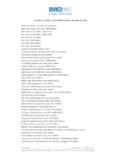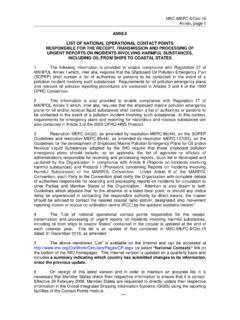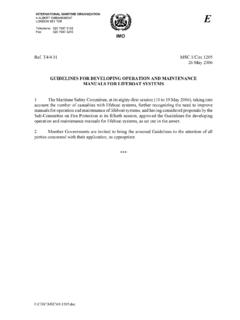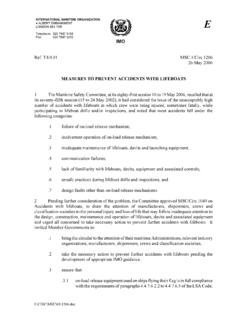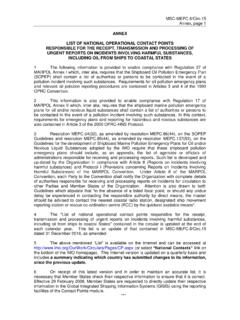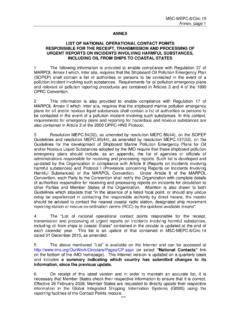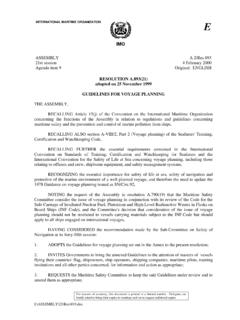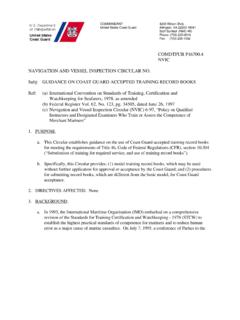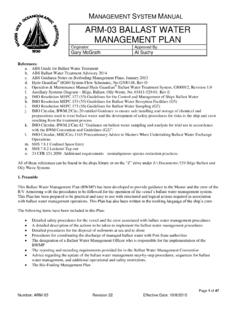Transcription of Guidelines for the Development of Tables of ... - IMO
1 Guidelines for the Development of Tables ofSeafarers shipboard working Arrangementsand Formats of Records of seafarers Hours of Work or Hours of RestPurpose1 These Guidelines are intended to assist competent authorities* todevelop Tables of shipboard working arrangements and records ofseafarers hours of work or hours of rest as required by the seafarers Hours of Work and the Manning of Ships Convention, 1996 (No. 180)(hereinafter referred to as Convention No. 180). They also take intoaccount the provisions on establishment of rest periods for watchkeepingpersonnel contained in the International Convention on Standards ofTraining, Certification and Watchkeeping for seafarers , 1978, as amended(hereinafter referred to as the STCW Convention).
2 Background2 Convention No. 180, which was adopted by the 84th (Maritime)session of the International Labour Conference (Geneva, 1996), introducedfor the first time comprehensive international provisions to establish limitson seafarers maximum working hours or minimum rest periods so as tomaintain safe ship operations and minimize fatigue. The Conventionincludes parts on Scope and Definitions (part I), seafarers Hours of Workand Hours of Rest (part II), Manning of Ships (part III), Responsibilities ofShipowners and Masters (part IV) and Application (part V). The substantivetext of Convention No. 180, which has been included at appendix 1,should be read prior to using these 5 of Convention No.
3 180 lays down,inter alia, the requirementsconcerning maximum hours of work or minimum hours of rest. Accordingto article 5, paragraph 7:The Member shall require the posting, in an easily accessible place,of a table with the shipboard working arrangements, which shallcontain for every position at least (a) the schedule of service at seaand service in port, and (b) the maximum hours of work or theminimum hours of rest required by the laws, regulations andcollective agreements in force in the flag State.*ILO Convention No. 180 provides that the termcompetent authoritymeans the minister, thegovernmental department or other authority having power to issue regulations, orders or otherinstructions having the force of law in respect of seafarers hours of work or rest or themanning of 8 further provides that:The table referred to shall be established in a standardized format inthe working language or languages of the ship and in to article 8, paragraph 1:The Member shall require that records of seafarers daily hours ofwork or of their daily hours of rest be maintained to allow monitoringof compliance with the provisions set out in Article 5.
4 The seafarershall receive a copy of the records pertaining to him or her whichshall be endorsed by the master, or a person authorized by themaster, and by the 2 further provides:The competent authority shall establish the format of the recordstaking into account any available International Labour Organizationguidelines or shall use any standard format prepared by theOrganization. The format shall be established in the language orlanguages provided by Article 5, paragraph the adoption of Convention No. 180, the MaritimeConference also adopted a resolution on the application of the Conventionin which it requested the International Labour Office, as a matter of priority,to develop the Guidelines and standardized format referred to in articles 5and 8, taking into account the texts and proposals made by theConference Committee and the discussions thereon.
5 It also recommendedthat a tripartite group of experts be convened by ILO to assist in thisexercise. It also adopted a resolution which declared that nothing inConvention No. 180 was intended to enable Members ratifying theConvention which are also Parties to the STCW Convention to applyprovisions to watchkeeping seafarers less favourable than those containedin the STCW Convention and are inconsistent with the minimum restperiods in that STCW Convention requires in regulation VIII/1 that Administra-tions shall, for the purposes of preventing fatigue, establish and enforce restperiods for watchkeeping personnel. In addition, the regulation requiresthat watch systems are arranged such that the efficiency of watchkeepingpersonnel is not impaired by fatigue and that duties are organized so thatthe first watch at the commencement of a voyage and subsequent relievingwatches are sufficiently rested and fit for related section of part A of the seafarers Training, Certificationand Watchkeeping Code (STCW Code) sets minimum periods andfrequency of rest and also requires that watch schedules be posted wherethey are easily accessible.
6 Part B of the STCW Code provides guidance onthe application of the provisions of regulation VIII/1, which includes thefactors to be taken into account in the prevention of fatigue, includingreference to the annex to resolution (18), Fatigue factors in manningand safety. The texts of the regulation and of part A and part B of the Codeare provided at appendix response to the ILO resolutions cited above in paragraph 5, and inkeeping with decisions taken by the 267th session (November 1996) ofILO s Governing Body and of the 68th session (May 1997) of IMO sMaritime Safety Committee, a Joint IMO/ILO working Group met inLondon from 19 to 23 January 1998 to consider,inter alia,thedevelopment of the Guidelines and standardized table showing shipboardworking arrangements and a standard format for records of seafarers hours of work or hours of rest as required by Convention No.
7 180. TheJoint working Group produced these Guidelines which, while referringprincipally to ILO Convention , also may assist competentauthorities to enforce the rest period requirements for watchkeepers inthe STCW Guidelines focus primarily on the requirements for thedevelopment of a table showing shipboard working arrangements and aformat for the records of seafarers hours of work or rest. When competentauthorities develop these Tables and formats, in fulfilment of theirConvention No. 180 obligation, they shall take the Guidelines intoaccount. Special attention is also drawn to the provisions of articles 9and 10, which set forth the role of the competent authority in theexamination and endorsement of records of hours of work or hours of rest,and the action to be taken when these records or other evidence indicateinfringements of the on the Development of a tableof shipboard working arrangements10 The table of shipboard working arrangements is intended to tabulatethe anticipated daily work or rest periods scheduled for all seafarers onboard a particular ship.
8 The table will allow seafarers to be aware of theroutine daily or weekly work periods normally expected of them at sea andin port. It may be subject to control to ensure that the shipboard workingarrangements are in conformity with the requirements of Convention , given the nature of work at sea, the table of shipboardworking arrangements can only be a guide to the anticipated normalworking arrangements on a particular ship and some deviation from thecontents of the table may occur. It should be stressed, therefore, that suchdeviations may not necessarily indicate non-compliance with the require-ments of Convention No. 180; this will only be established by reference todetailed records of hours worked or periods of rest which also need to bemaintained (see paragraphs 16 24).
9 12 Convention No. 180 requires that the table of shipboard workingarrangements is to be established in a standardized format , and this willfacilitate understanding by seafarers and competent authorities. The tableshould:.cover the anticipated schedule of service at sea and in port for eachseafarer employed on board; to watchkeeping duties as well as any additional work which isexpected;.contain the maximum hours of work or the minimum hours of restrequired by the laws, regulations or collective agreements in forcein the flag State;.provide a total scheduled work-rest-hour figure for each seafarer; written in the working language or languages of the ship and the case of many, if not most, ship operations it will be possible for acompetent authority to produce a standard format for such a table forcompletion by companies operating ships flying its flag.
10 The model formatattached at appendix 3 to these Guidelines would satisfy the requirementsof Convention No. 180 and the STCW Convention and could be adaptedas necessary to meet any specific national competent authority may also make provision for the approval ofalternative formats which, while satisfying the requirements of ConventionNo. 180, would be more appropriate in the circumstances of specific is recommended that, when developing a standard format oralternative formats, the competent authority should consult with ship-owners and seafarers for the Development of formats of the recordsof seafarers s hours of work or their hours of rest16 Articles 8, 9, 10, 13 and 15 of Convention No.


